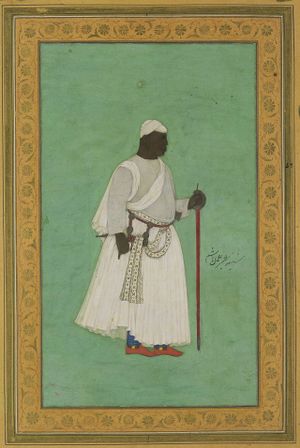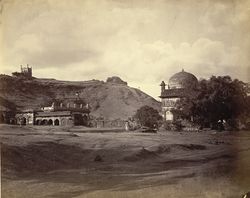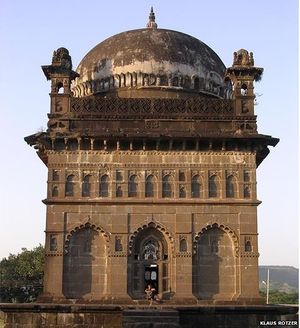مالك عنبر
| مالك عنبر | |
|---|---|
 | |
| وُلد | 1549 |
| توفى | 13 مايو 1626 |
| الولاء | نظام شاه أحمدنگر |
مالك عنبر Malik Ambar (عاش 1549 – 13 مايو 1626) كان حبشياً وُلِد في هرر، وباعه أبواه طفلاً بسبب الفاقة. وأُحضِر في نهاية المطاف إلى الهند وبقي عبداً لدى من اشتروه. إلا أنه بمرور الوقت قام بإنشاء جيش خاص ضم 1500 جندي. أقام هذا الجيش في منطقة الدكن وقد استأجره العديد من الملوك المحليين. وأخيراً بزغ ليصبح وزيراً بالغ الشهرة في سلطنة أحمدنگر، مبدياً مهارات ادارية في مختلف المجالات. مالك يعتبر رائداً في حرب العصابات في منطقة الدكن. ويُنسب إليه فضل القيام بتنظيم موارد أجزاء كبيرة من منطقة الدكن، وكان ذلك أساساً للعديد من التنظيمات اللاحقة. وقد توفي في 1626. ويحظى حتى اليوم بإجلال وتقدير كبيرين لدى شيدي گجرات. فقد روّض المغل عادل شاه من بيجاپور وفرض عليهم التواضع ورفع من قدر النظام شاه الذي كان يتهاوى مجيئه.[3][4]
مالك عنبر وتصميماته لنظام النهر (الترع)
اشتهر مالك عنبر بشكل خاص بتصميمه "النهر"، وهو نظام ري لمدينة تُدعى خادكي وتثعرف الآن بإسم أورانگ آباد. أتم ملك عنبر نظام النهر في خمسة عشر شهراً، وتكلف قيمة اسميه قدرها إثنين ونصف لخ روپية. هذه المدينة تقع على ضفاف خم، وهو غدير دائم ينبع من المرتفعات المجاورة. "[5] * قارون أو القارون هو اسم شخص بالغ الثراء بخيل في أيام النبي موسى كما يذكر القرآن.
Water was supplied to the city of Khadki from the famous Panchakki (Pan from Hindi paani means water and Chakki means a tread-mill) which drove the water down the نهر عنبري (نهر عنبر) from the stream called Kham referred earlier here, to the city. The blades of the Panchakki used to rotate by the water falling on them from that stream and with the aid of a wooden valve turn the flow into that canal, the Nahr, for the city. The tower of this Panchakki housing a valve and air outlet still exists in ruins today in the old precincts of Aurangabad in Labour Colony, Junabazar area along with other relics of Malik Ambar's times .
نزاعه مع المغل
Malik Ambar thrust defeats on the Mughal General Khan Khanan many times and attacked Ahmadnagar often. Lakhuji Jadhavrao, Maloji Bhosale, Shahaji Bhosale and other Maratha chiefs had gained great prominence during this period. With the help of these Maratha Chiefs, Malik Ambar had captured Ahmednagar Fort and town from the Mughals. But in one of the battles Malik Ambar was defeated by the Mughals and had to lose the fort of Ahmadnagar. Many Maratha Chiefs and especially Lakhuji Jadhavrao joined the Mughals. شاه جهان once again laid a crushing blow to Malik Ambar in one of the battles and further decreased his power. Malik Ambar was a great statesman and soldier. He humbled the might of the Mughal and Adil Shah of Bijapur and raised the falling status of the Nizam Shah. Though defeated by the Mughals he was never cowed down by their might.
وفاته

He died in 1626 at the age of 80. Malik Ambar had by his Siddi wife, Bibi Karima two sons; Fateh Khan and Changiz Khan and four daughters.[6]
One of his daughters was married to a prince of the Ahmednagar royal family who was later, through Malik Ambar's aid crowned as السلطان مرتضى نظام شاه الثاني.[7] The second and third daughters respectively were called Shahir Banu and Azija Banu, the latter of whom married a nobleman named سيدي عبد الله.[8]
فاتح خان succeeded his father as the regent of the Nizam Shahs. However, he did not possess his predecessor's political and military prowess. Through were a series of internal struggles within the nobility (which included Fateh Khan assassinating his nephew, السلطان برهان نظام شاه الثالث)، the sultanate fell to the Mughal Empire within ten years of Ambar's death.
ابنته الصغرى تزوجها القائد الشركسي لجيش أحمدنگر، مقرّب خان الذي أصبح لاحقاً قائداً لجيوش سلطان المغل وحصل على لقب رستم خان بهادر فيروز جنگ.[9][10] وقد اشتهر بمشاركته في العديد من الحملات العسكرية الهامة، مثل حروب قندهار ضد الشاه عباس من فارس. وقد قتله الأمير مراد بخش في معركة ساموگره أثناء حرب الخلافة المغلية في 1658.[11]
تعليقات المؤرخين
A noted historian Dr. Beni Prasad notes: "The chief importance of the Deccan campaigns of the Mughals lies in the opportunities of military training and political power which they afforded to the Marathas. Malik Ambar, who was a great master of the art of guerrilla warfare as Shivaji himself, stands as the head of the builders of the Maratha nationality. His primary object was to serve the interest of his own master, but unconsciously he nourished into strength a power which more than avenged the injuries of the South on the Northern power."[بحاجة لمصدر]
تأسيس أورانگ آباد
قام مالك عنبر بتأسيس وإعمار مدينة خدكي في 1610. وبعد وفاته في 1626، تغير الاسم إلى فاتح پور على يد ابنه ووريثه فاتح خان. وحين غزا أورانگ زيب، سلطان المغل، الدكن في عام 1653، جعل من فاتح پور عاصمة له وغير اسمها إلى أورانگ آباد. ومنذ ذلك الحين تُعرف بإسم أورانگ آباد. وثمة عاصمتان هما ‘Pratisthan’ (پايثان) أي عاصمة ساتاڤاهاناس (القرن الثاني ق.م. إلى القرن الثالث الميلادي) و دڤاگيري - دولت آباد عاصمة كل من ياداڤا ومحمد بن تغلق تقع ضمن حدود أورانگ آباد.
انظر أيضاً
الهامش
- ^ Sheikh Chand, Malik Ambar,"Ehde Afreen; Hyderabad; 1929
- ^ Times of India, Plus Supplement, July 1999,
- ^ [1]
- ^ Michell, George & Mark Zebrowski. Architecture and Art of the Deccan Sultanates (The New Cambridge History of India Vol. I:7), Cambridge University Press, Cambridge, 1999, ISBN 0-521-56321-6, p.11-12
- ^ Qureshi, Dulari. Tourism Potential in Aurangabad. ISBN 8186050442.
- ^ Shanti Sadiq Ali,"The African Dispersal in the Deccan: From Medieval to Modern Times" p.99
- ^ Richard M. Eaton,"Slavery and South Asian History" p.126
- ^ Shanti Sadiq Ali,"The African Dispersal in the Deccan: From Medieval to Modern Times" p.104
- ^ Edward J. Rapson,"The Cambridge History of India, Volume 1" p.189
- ^ John Cadgwan Powell Price,"A History of India" p.313
- ^ Muni Lal,"Aurangzeb" p.93
